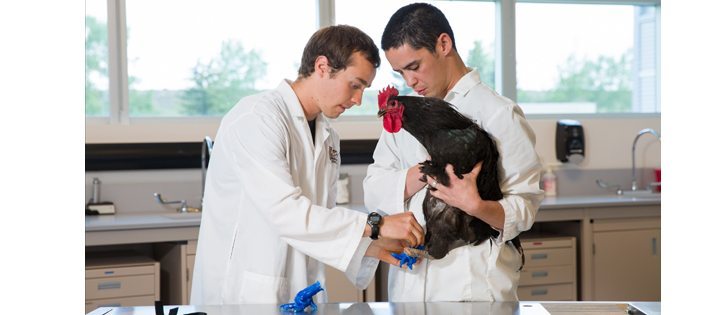After a couple of stumbles, a rooster named Foghorn is now putting his best foot forward, thanks to an engineering feat from the University of Calgary’s faculty of veterinary medicine and school of mechanical engineering.
Foghorn was a backyard chicken in Calgary who lost his feet due to frostbite. He was barely walking on bloody stumps when he was seized by the SPCA and became a subject for the veterinary school.
Daniel Pang, an assistant professor at the veterinary school who studies small animal pain and welfare, heard about the bird and wanted to help. Working with undergraduate student Doug Kondro and professor Mark Ungrin, Pang hatched a plan to build Foghorn new feet.
Ungrin, whose background is cell biology and tissue engineering, develops veterinary simulations for students to learn on, while Kondro is working in the laboratory on biomedical engineering projects that include working with 3-D printers, plastics and silicon.
Kondro made moulds of the bird’s stumps and then developed the inside skeleton from hard plastic. These were encased in silicon rubber and made to look like chicken feet.
The first attempts did not work properly because the angle of the foot was incorrect. However, they eventually came up with a walking model after some reworking.
Read Also

Europe holds promise for Canadian lentils
Pulse Canada is trying to help boost lentil consumption in Europe, which is already the fourth largest market.
The feet were fitted on Foghorn and attached with zip ties. The talons do not have moving joints, but the rooster soon learned to walk in his pen without difficulty.
“His first few steps were quite awkward, but he actually got into the swing of things pretty quick,” said Kondro.
Foghorn was adopted and now lives on an acreage near Didsbury north of Calgary.
This was not a frivolous project.
Knowledge gained from this work could lead to further projects in building better prosthetics for larger animals or people.
“One of the strengths of the 3D technology is that it is not just one size fits all,” Ungrin said.
“It literally is custom fit to that animal because we can scan and we can print and we can adjust.”
Custom fitted prosthetics exist now but take a long time to build. A 3D printer can be calibrated to fit to the individual patient, and a prototype can be made in a few hours, depending on the size of the object.
















